Note
- 17 May 2023: Updated.
- 28 Feb 2019: Process and Criteria added.
- 31 Jan 2018: Created.
Different Terms 不同的名稱
- Value analysis 價值分析 - Original name used to refer to the methodology used to analyse the values of the various components of a product.
- Value engineering 價值工程 - A later name used when the methodology has been more well established as a system. It is said to be more focused on the technical aspects of the value study.
- Value management 價值管理 - An even later name used when the methodology has been adopted for services and processes. It is said to be more focused on the strategic or policy aspects of the study.
- Value methodology 價值方法 - A name referring to the methodology used in the value study.
- They should now be regarded as synonymous without being too academic to distinguish between them.
Value 價值
- Standard equation: Value ≈ Functions / Costs.
標準方程式: 價值 ≈ 功能 / 成本。 - Modified equation: Value ≈ Functions / Resources.
修訂方程式: 價值 ≈ 功能 / 資源。 - “Functions” can include prices, benefits, uses, worth, relationship, etc. of ALL parties.
“功能”可包含各方的價格、好處、用處、代替成本、關係、等等。 - "Resources” can include costs, time, labour, materials, plant, effort, waste, etc. of ALL parties.
“資源”可包含各方的成本、時間、人工、材料、機械、努力、損耗、等等。
Worth 代替成本
- "Worth" has a special meaning in VE/VM. It means the cost of achieving the same function using alternative means. If the worth is less than the cost of the present means, the present means has poor value.
英文的"worth"一般亦解作價值或值得否,但在價值工程,它有特別的含意,乃指達到同樣功能的其他辦法的成本。若此"代替成本"比現行方法的成本低,則意味現行方法的價值低。
Value Index 價值指數(性價比)
- Value index = worth / cost of a function = function worth / function cost . If worth < cost, i.e. value index < 1, then the function has poor value.
- Somebody uses value index = cost / worth. If cost > worth, i.e., value index > 1, then the function has poor value. It is more suitably called “value opportunity index”.
- It is suggested to use the former formula, because it is more consistent with the Value ≈ Functions / Resources formula and the intuition that higher value ratio is better.
("value opportunity index" added, 17 May 2023)
Purposes of VM 價值管理的目的
- Not necessarily cost reduction.
不一定是減錢。 - “Cost” can be non-financial.
”成本” 可以不是金錢上的。 - Enhancing Value by:
提升價值,可:- Reducing resources;
減低資源; - Keeping resources unchanged;
維持資源不變; - Increasing resources to a lesser extent;
增加資源但幅度較細; - Increasing the extent of existing functions;
增加現有的功能的程度; - Expanding the scope of functions.
擴大功能的範圍。
- Reducing resources;
Value Study 價值研究
- A specific study on a particular product, service, process or entire project using VA / VE / VM to improve value.
- Usually done by conducting a workshop attended by many stakeholders representing different expertise, needs and interests.
- A value study should have the following three-stage process:
- Pre-workshop preparation;
- Value workshop;
- Post-workshop documentation and implementation.
Six-Phase Value Workshop 六階段價值工作坊
- Introduction Phase (preceding the 6 phases)
介紹階段 (六階段前) - Information Phase
資訊明暸階段 - Function Analysis Phase
功能分析階段 - Creative Phase / Creativity Phase
方案創造階段 - Evaluation Phase
方案評估階段 - Development Phase
擇優深化階段 - Presentation Phase
總結報告階段
Various Management Models
Integrated Workshops
- The Housing Department in Hong Kong requires its projects to conduct partnering workshops while the Architectural Services Department and other government works department in Hong Kong require their projects to conduct VM workshops or integrated workshops covering VM, partnering, quality, risks, and integrity managements.
- Partnering, quality and risks managements all adopt a cyclical series of processes for continual improvement.
- The processes are very similar to that adopted by VM.
- The systematic value methodology can be effectively applied to conduct the integrated workshops.
- The following touches integrated workshops, not just value management workshops.
(Sub-section added, 17 May 2023)
Similarity of the Processes of Various Management Models
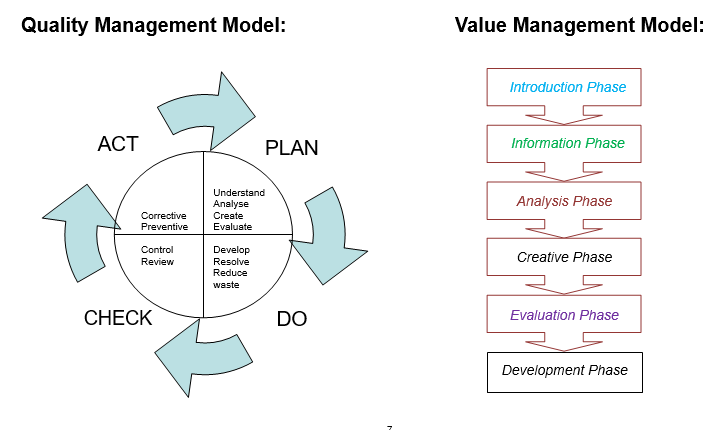
(Diagram added, 17 May 2023)
- They all use similar sequential processes – analyse and improve.
- They all call for cyclical and continual review and improvements.
- A VM workshop is only a start at the “plan” stage and that continual review and improvements would be required throughout the course of project delivery.
(Revised, 17 May 2023)
Integration of Various Management Models for Project Delivery
- Integrity management is the backbone throughout, and can be considered as part of the risk management.
- Quality, health and safety should be the basic minima that a project should achieve. They are only a sub-set of all the risks which may be encountered.
- Risk management is about preventing or mitigating risks in order to make a project successful.
- Value management is about adding value to the project on top of mere success.
- Non-contractual partnering helps people work easier and smoothly.
Whole Scheme of Workshop
- Pre-workshop meeting to understand the project.
- Pre-workshop survey of initial expectations, major objectives and issues.
- Workshop (one day for integrated or half day for partnering):
- Introduction Phase
- Information Phase
- Analysis Phase
- <If partnering included: Drafting partnering charter (partnering attitudes, goals, objectives)>
- Creative Phase / Creativity Phase
- Evaluation Phase
- Development Phase.
- Post workshop report (Presentation Phase).
- Regular reviews.
(Section added, 17 May 2023)
Introduction Phase
(Section added, 17 May 2023)
Rundown
- Welcome and introduction by facilitator.
- Presenting workshop objectives by facilitator.
- Stating ground rules by facilitator.
- Opening speeches by senior management stating project objects and expectations.
- Self-introduction of participants.
- House-warming games (if partnering included).
- Group photos.
Some Workshop Objectives
- Understand project objectives better.
- Incorporate core values and corporate social responsibilities in project implementation.
- Promote awareness of the importance and good practice of planning and design for safety in project construction.
- Focus on creative co-operation and avoid adversarial confrontation.
- Build working relationships based on mutual respect, trust and integrity.
- Establish a more dynamic project organizational structure and clear line of communication.
- Develop a formal problem-solving action plan and dispute avoidance mechanism.
- Develop a mechanism for conducting the partnering review regularly.
Ground Rules of Workshop
- Mutual trust and respect.
- Equal right and opportunity.
- Equal votes.
- No pre-judgement.
- Non-adversarial.
- Better value creation.
Focus to Enhance Values

Some Project Objectives
- Achieve better project value through mutual recognition and development of improvement opportunities.
- Enhance effectiveness by preventing unnecessary cost and time escalations, delays, or unresolved issues.
- Reduce the project time and improve quality and buildability.
- Clarify common objectives.
- Clarify project requirements.
- Identify opportunities for simplifying procedures and potential savings in time or costs.
Cultural Shift Required
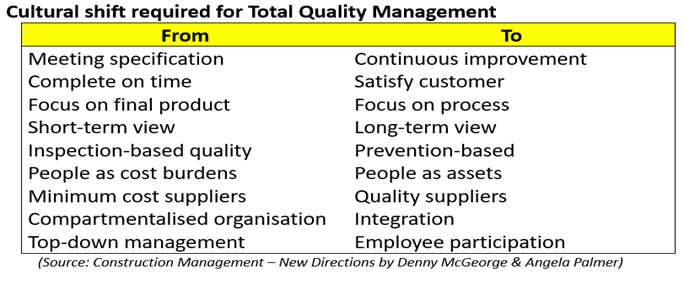
Information Phase
(Section added, 17 May 2023)
Rundown
- Presentation by Consultants:
- Project background
- Major design features
- Expectations.
- Presentation by Contractor (if Contractor involved):
- Site set-up
- Programme
- Special measures
- Expectations.
Analysis Phase
Rundown
- Surveying partnering attitudes (if partnering included).
- Identifying goals and objectives (Why).
- Identifying issues, concerns and risks (What / negating Why).
- Both through:
- Group discussions:
- Each group for different aspects
- Identify as much items as possible
- Each member writes down a few before group sharing
- Register all items on a chart before discussion
- Discuss to expand registered items
- Do not jump to solutions
- Presentation by group representatives
- Voting for the most important items.
- Group discussions:
(Sub-section added, 17 May 2023)
Function analysis
- Analysing the functions of the project, process or product to be value-studied and its components is the most important task in value management.
- Read the recommended reading materials on the building-up of FAST diagram (Function Analysis System Technique).
(Sub-section added, 17 May 2023)
Bear in Mind Why-How Diagram
- For layman participants in a VM workshop, it may be easier to ask them to think along the following diagram:
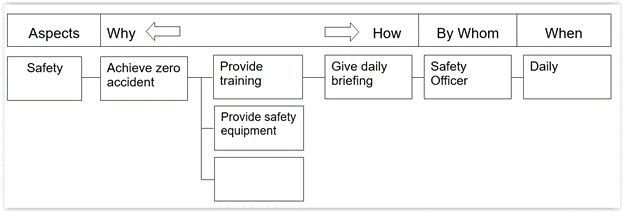
- This is similar to the How-Why logic used in FAST diagram.
- Useful questions:
- Why do this?
- What obstructions?
- Why not that?
- What can be done?
- What else can be done?
(Sub-section added, 17 May 2023)
Persistent Critical Questions
- First ask "Do What" to identify the functions of the particular product, service, process or entire project being studied.
- e.g. [Do A], [Do B], [Do C].
- Phrase "Do What" in the form of a verb followed by a measurable noun to represent a simple and single function.
- The verb is to represent the action achieving the function.
- The measurable noun should represent the object to be acted upon to achieve the function.
- The objects should not use the names of the actual components making up the product, service, process or project so as to free up the choice of the components.
- Then ask "<-- Why" and "How -->" to link up the relationship of the functions.
- Why? [Do A] <-- in order to <-- [Do B] <-- in order to <-- [Do C].
- How? [Do A] -- by --> [Do B] -- by --> [Do C].
- Linked path: [Do A] -- [Do B] -- [Do C].
- Asking ”Why“ can help align objectives and ultimate goals on the far left.
- There can be functions not linked up in the horizontal manner but branched off at the same time, e,g. when [Do B], [Do C] also happens at the same time.
- There can also be parallel paths, or functions which happen at one time or all the time.
- Then ask "Why not" and "What else" to challenge the existing and generate new ideas.
Some Tips on Goals and Objectives
|
Project |
Process |
Attitude |
|
|
|
- Goals and objectives are not exactly functions. However, using these terms may be easier for layman participants.
(Sub-section added, 17 May 2023)
Scoring of Goals and Objectives
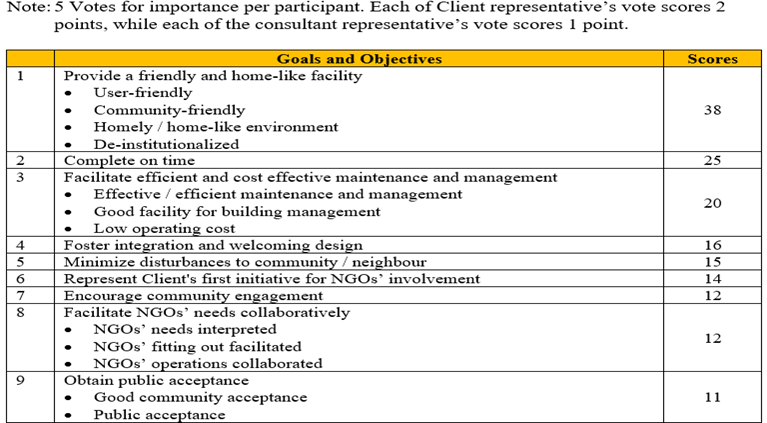
(Sub-section added, 17 May 2023)
Scoring of Issues, Concerns and Risks
- Issues, concerns and risks are factors which hinder the achievement of goals and objectives. Resolution of them will come closer to the goals and objectives.
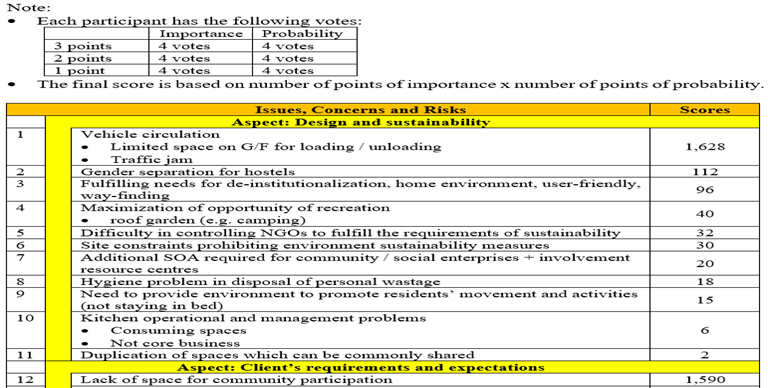
(Sub-section added, 17 May 2023)
Function Analysis by Components
- The function and current cost of each component are analysed in a table. The worth means the cost of an alternative design achieving the same function. If there is an alternative costing less, there will be opportunity to improve value.
|
Item |
Description |
Basic Function |
Cost |
Worth |
Comments |
|
|
Verb |
Noun |
|||||
|
1 |
Component A |
|
|
|
|
|
|
2 |
Component B |
|
|
|
|
|
- The function is more specific to the component than to the overall project.
- When generating ideas in the next Creative Phase, it will be asked what alternatives can be proposed to serve the same function of each component.
(Sub-section added, 17 May 2023)
Creative Phase / Creativity Phase
Rundown
- Creatively proposing actions for priority issues, corporate social responsibilities, safety pledge to achieve the same functions, with action plan (How, By Whom and When).
- Through:
- Group discussions
- Presentation by group representatives.
(Sub-section added, 17 May 2023)
Brainstorming Rules
- Open up mindset.
- State ideas quickly.
- Quantity more important.
- “Free-wheeling” welcome.
- OK to state the obvious, to repeat, to think out of the box.
- OK to add upon, combine, improve on others’.
- OK to twist or turn around others’.
- No explanation required.
- No criticism, doubting, judgement.
(Revised, 17 May 2023)
Evaluation Phase
Evaluation as a Phase or a Technique
- The Evaluation Phase follows after the Creative Phase where creative ideas are evaluated to judge their values.
- During the Information Phase and Function Analysis Phase, some prioritization, shortlisting and selection may be conducted.
- Each of these actions would involve some kind of evaluation techniques and judgement.
- Therefore, evaluation occurs across the whole process of value study.
(Sub-section added, 17 May 2023)
Comparison of Advantages vs Disadvantages
- To evaluate, the simplest way is to prepare tables to show the advantages vs the disadvantages of each idea generated.
|
Ideas |
Advantages |
Disadvantages |
|
Component A – Function X |
|
|
|
<> |
|
|
|
<> |
|
|
|
Component B – Function Y |
|
|
|
<> |
|
|
|
<> |
|
|
- However, it lacks an evaluation of the degrees of the merits by means of ranking or scoring relative to desired criteria.
- The table can be expanded to show the criteria and the ranking or scoring.
|
Ideas |
Advantages |
Disadvantages |
Criteria
|
Ranks or Scores |
||||
|
A |
B |
C |
D |
E |
||||
|
Component A – Function X |
|
|
|
|
|
|
|
|
|
<> |
|
|
|
|
|
|
|
|
|
<> |
|
|
|
|
|
|
|
|
|
Component B – Function Y |
|
|
|
|
|
|
|
|
|
<> |
|
|
|
|
|
|
|
|
|
<> |
|
|
|
|
|
|
|
|
- The process of developing the criteria and giving ranks or scores are described below. Some of which do not have the advantages and disadvantages specifically stated but are based on the perceptions of the individual participants.
- In any case, the advantages and disadvantages will be useful when writing the workshop report to support the recommendations.
(Sub-section added, 17 May 2023)
Process
- Why?
- Select the most significant and promising ideas for adoption
- How?
- Consolidate ideas
- Group similar ideas (no screening!)
- Review ideas critically
- Advocate or doubt-cast (but no scoring yet!)
- Adjust and expand ideas
- Determine criteria
- Observe overall objectives
- Observe individual functions
- Suggest criteria (no judging yet!)
- Group similar criteria (no screening yet!)
- Review criteria
- Adjust and expand criteria
- Weigh criteria (5 to 10)
- Score ideas
- Recommend ideas
- Consolidate ideas
- Note: Some people consider that the criteria and weightings should be determined first so as not to be affected by the ideas generated.
(Sub-section added, 8 Feb 2019)
Criteria / Performance Attributes
- Using a noun, e.g. time, as a criteria is not sufficient. Do you want shorter time (fast project) or longer time (long lasting battery)? A criteria should have some qualitative or quantitative qualifiers.
- Some qualitative qualifiers:
- Lower, higher
- Shorter, faster, longer, just in time
- Excellent, better, just OK
- Easier
- Some quantitative qualifiers preceded by "more than / less than / equal to" and the like:
- Monetary
- Temperature
- Quality grade
- Environmental assessment grade
- Life span
- Aspects to study:
- Quality
- Price
- Life cycle cost
- Time
- Life span
- Maintenance
- Operational use
- Risks
- Safety
- Combine a qualifier and an aspect to form a qualitative criteria, e.g.:
- Shorter time
- Good safety
- Qualitative criteria may be more specific and may become screening criteria, e.g:
- Less than one month
- Zero accident
- Not more than ... accident rate
(Sub-section added, 8 Feb 2019)
Units of Measurement
- When all the functions and resources can be converted into monetary units, the evaluation of the values will be much easier.
- However, not all can be converted into monetary units, then some other common units of measurement should be devised, e.g. some scientific units, mass, energy, speed, time.
- Yet, in many cases, there are no suitable monetary units or scientific units, human subjective views are to be adopted.
- When human subjective views are to be adopted as units of measurement, they have to be quantified, even for qualitative views, after thorough discussions.
Voting
- One can make and record one's own choices in whatever manner, but voting is the best way to express collective views in a quantitative manner.
- VM is about collective wisdom and collective decision.
- Dominance by the bosses or vocal people should be avoided.
- During group discussions, vocal people would involuntarily speak more to express their views or influence other people.
- Voting giving better chances for everybody to express free will and choices should be preferred.
- Voting can be by:
- Ballot paper - confidential, but needs time to count.
- Show of hands - quick, but may be dominated by bosses or vocal people.
- Show of figures (0 for no support, 1 for least support, 5 for strongest support) - expressing different degrees of support.
- Marking or sticking voting points on a displayed list of choices - quick and not dominated by others.
- When selecting top few choices out of many choices, give sufficient number of votes to each participant:
- e.g. for 30 participants each suggesting 3 choices, there will be 90 choices.
- When the participants are asked to vote for the top 10 choices, and each participant is allowed 10 votes, then the total number of votes will be 300 votes.
- Which number when divided by 90 choices will mean 5 votes per choice on the average.
- If the participants' choices are very diversified, each of the top 10 choices may only have a small number of choices of 10 to 20.
- Therefore, it would be better to give more than 10 votes to each participant.
- If desired to amplify the preferences between each participant's own choices:
- Request the participant to indicate on each vote a weighting on a scale of 5 or 3.
Tabular Comparison
- Workshop participants may be asked to give scores on a scale of 10 for expectation and achievement to identify the gap between the two.
- An example is as follows:
- The aspects help people focus on the areas for present consideration and further study.
- Each aspect may be guided with evaluation criteria (e.g. on time, within budget, least environmental harm, good health, good quality, good safety, or further breakdown) for scoring.
- The scoring direction must be clarified, e.g. time or cost may be scored as 0 for very poor time or cost control or as least time or cost overrun, of totally reversed meanings.
- In this example, 5 is treated as the passing score for on time and within budget, and 10 as the excellent performance.
- The scoring scale may be a 5-point scale such as:
- 5 for excellent;
- 4 for good;
- 3 for fair;
- 2 for marginal;
- 1 for worth something;
- 0 for not supported.
Column Chart
- The results may be presented as a column chart for visualisation:
Bar Chart
- Or as a bar chart:
Collective Scoring
- It may not be possible to agree the scores between a group of participants quickly without being dominated.
- Voting may need to be conducted.
- Each participant will give his/her score for each Aspect.
- The scores are then totalled and averaged per Aspect as follows:
- A show of figures based on a 5-point score will be quicker than a 10-point score.
Radar Chart
- For an even quicker gathering and presentation of the scores at the workshop, a radar chart would be very useful.
- Here, there are three participants each having been requested to indicate their expectation and achievement scores for each aspect by putting a dot on a 10-point scale axis.
- After that, the approximate centres of gravity of the dots of different aspects are connected together.
- The distance between the two connecting loops will be the gap.
- For a workshop where the number of aspects or criteria to be scored is unknown in advance, a hand drawn circular radar chart with the number of axes flexibly added may be adopted:
Pareto Principle
- Also known as the 80/20 rule, or the law of the vital few.
- Roughly 80% of the effects come from 20% of the causes.
- Applying the principle generally:
- Focus on the significant 20% causes to generate 80% effects.
- When applied to construction costing:
- 20% of the items in the pricing documents represent 80% of the costs.
Most Cost Significant Items
- The most cost significant items should be selected for value study because they have the greatest potential for and impact of cost savings.
- Components listed in the regular cost reports:
- Sorted in the descending order of their costs:
- Visualisation:
Priority Rating of Intangible Items
- For intangible aspects of products, services, processes or projects, they can be rated by a single set or two sets of scores as follows, where the product score = importance score x probability score:
- Similar scoring concept has been used in risk management.
- The same can also be applied to the selection of value options.
- For physical components of products and projects, only one final value option would be chosen for a component.
- However, for intangible aspects of products, services, processes and projects, more than one value option may be adopted for achieving the same objective..
- But, because of limited resources, not all can be adopted.
- The above multiple scoring method may be used to select the top priority value options.
Comparison of Two Options
- Like school examinations, the simplest way to calculate scores to compare between two options (projects below) would be as follows:
- This is useful when every score counts for precision (passing marks in examination) and the scores at columns B and C can be countable.
- Collective scoring as described above may be conducted when precision is not that critical.
Multiple Criteria Comparison
- If the aspects or criteria should not carry equal weight, then weighting of the aspects or criteria would be required:
- The following shows the results if the same group of participants scored on a 10-point scale at the same time:
- The following shows the results if the same group of participants scored on a 5-point scale at the same time:
- The above 3 sets of results show that the absolute degree of accuracies may vary but the relative merits are not affected very much.
Pairwise Comparisons
- A more detailed method to determine the relative ranking of different aspects or criteria is by pairwise comparison.
- A pairwise comparison is done by asking: between the pair of aspects or criteria at the left and at the top, which one is preferred, then write down the preferred one in the intersecting box.
- The total occurrence is then counted and the proportion calculated.
- The following is based on the ranking shown above.
- Note that if the comparison is done independently, the results may be very different because participants may say safety is of paramount importance.
- The above shows that Environment having the lowest ranking will score zero.
- This would not be used when the proportion is used as weightings.
- The following gives at least one vote for one aspect to avoid zero proportion, the ranking remains the same.
- Weighting may be added when doing the pairwise comparison by giving, for example, 3 for strongly preferred, 2 for moderately preferred, 1 for preferred.
- There are many formats and ways of pairwise comparison tables.
Remarks
- People generally understand that “Cost” means lower cost and “Time” means shorter time in project delivery, but “Time” may also mean longer time span. Therefore, more precise words should be used as appropriate.
- “Cost” has been given as one of the criteria for evaluation in the above examples because this is probably the most important criteria for most people.
- However, when one considers the formula, Value = Functions / Resources (or Costs), one will find that costs should be expressed as the denominator, while the other evaluation criteria described above are in fact to evaluate the functions not the costs. The income should in fact be one of the functions to be used as the numerator. Therefore, if a value calculation is to be done in the Development Phase, the cost should be omitted from the above criteria.
- For some integrated workshops where the project budget is not a problem, cost may not be the most important issue, and the cost information may not be available for evaluation. Non-monetary criteria should then be adopted.
- Pair-wise comparison is the usually suggested selection method suggested by VM books, but it would be time consuming to go through each pair of criteria to score.
- Scoring of marking scheme by groups may be denominated by vocal group members
- Open floor voting is the most expedient method.
- Through:
- Vote by sticking adhesive dots on displayed charts
- Each member has more than one vote to build up enough votes for priority items
- Each voting dot may score from 1 to 5
- Vote in one colour for the most important/serious items
- Vote in another colour for the most feasible/probable items
- Seriousness x probability score = usual risk scoring method
- Importance x feasibility scores = also a good indicator
(Sub-section added, 17 May 2023)
Development Phase
Rundown
- Reviewing results of evaluation.
- Adopting action plan.
- Presenting results of survey of partnering attitudes (if partnering adopted).
- Agreeing issue resolution matrix (if partnering adopted).
- Agreeing champion team (if partnering adopted).
- Agreeing regular review meetings (structures, representatives, frequency) (if partnering adopted).
- Closing address by senior management.
- Closing by facilitator.
- Exchanging signed partnering charter (if partnering adopted).
- Photo taking.
(Sub-section added, 17 May 2023)
Action Plan of Applying VM on Intangible Aspects
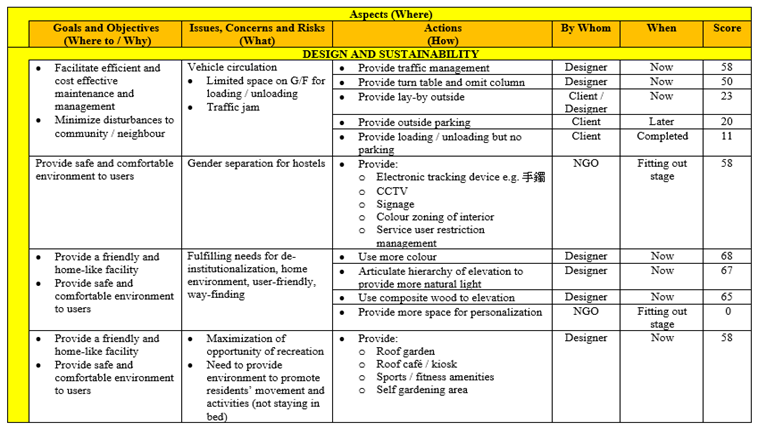
- The above are simple action plans in lieu of full blown VM reports. Full blown VM reports will give more supporting information as to the advantages, disadvantages, life cycle costs, ancillary measures to achieve, etc.
(Second table and notes added, 17 May 2023)
Life Cycle Costs
- When comparing different options having different patterns of initial costs and long term running costs, their life cycle costs should be worked out and compared.
- See Life Cycle Costing.
Calculation Template
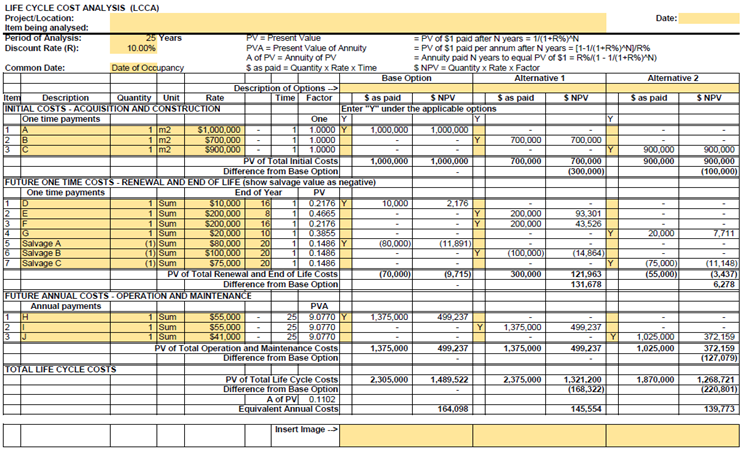
(Sub-section added, 17 May 2023)
Value = Functions / Costs
- If the previous evaluation table is expanded to give the value indices of all the evaluated ideas (options) using Value = Functions / Costs, it may be able to discover that in some instances some cheaper ideas may be of higher values.
|
Ideas |
Advantages |
Disadvantages |
Criteria
|
Scores (representing functions) |
Cost |
Value = Score / Cost |
||||
|
A |
B |
C |
D |
E |
||||||
|
Component A – Function X |
|
|
|
|
|
|
|
|
|
|
|
<> |
|
|
|
|
|
|
|
50 |
100 |
0.5 |
|
<> |
|
|
|
|
|
|
|
70 |
50 |
1.4 |
|
Component B – Function Y |
|
|
|
|
|
|
|
|
|
|
|
<> |
|
|
|
|
|
|
|
|
|
|
|
<> |
|
|
|
|
|
|
|
|
|
|
(Sub-section added, 17 May 2023)
Presentation Phase
- The workshop report (value study report) will be prepared to record the processes, results and recommendations (change proposals) of the workshop for the management’s consideration and decision. The report will be presented in a full-blown 5-day workshop but will only be prepared in Hong Kong after the half day or one day workshop.
(Section added, 17 May 2023)
Reading materials
- Value Methodology Flyer published by HKIVM: This gives a one-page essence of the concept of value methodology.
- Environment, Transport and Works Bureau Technical Circular (Works) No. 35/2002 – Implementation of value management in public works projects dated 13 August 2022: VM studies to be conducted for projects estimated to cost more than HK$200 million.
- Value Methodology Standard March 2015 published by SAVE: This book provides a basic overview of value methodology, some common terms, and the standard 6-phase VM study.
- Value Engineering Workshop Guide published by Washington State Department of Transport: This book provides a very good guide to conducting VM studies. The names of the phases follow SAVE's standards.
- Value Engineering Manual June 2014 published by West Virginia Department of Transportation: This is another good book of complete coverage. The names of the phases are not the same as SAVE's standard. The concept is the same.
- Value Management and Value Engineering 1st Edition, January 2017 published by RICS: This book describes VM and VE from the UK perspective.
- Risk Management User Manual June 2005 by Environment Transport and Works Bureau: This manual covers risk management. The methodology adopted is very similar to value methodology.
- Health and Safety Design Management Guidance Notes by ETWB, HKHA & OSHC: This book is on health and safety design management. The principles can be shared with value management and risk management.
(Section added, 17 May 2023)